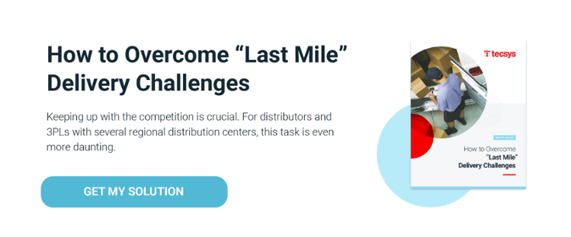E-commerce Distribution: How to Embark on a Digital Transformation

According to the Gartner Digital Commerce Vendor Guide, 2018, “Digital commerce is a major component of a superior customer experience, with a growing ecosystem of technologies, vendors, and services.” Opportunities abound when trading partners work together to create a seamless, automated, and error-free supply chain with a focus on providing a simple, effective, and enjoyable user experience.
Many companies excel at managing a large volume of digital transactions with both vendors and customers, while others have focused on the ‘online’ engagement. The fact is that both areas are critical to reaching a high level of digital maturity and the resulting benefits. In this blog, we will look at some of the key findings for wholesale distribution companies embarking on a digital transformation of their business through e-commerce distribution.
Investment and Cooperation
A digital transformation initiative through e-commerce distribution is only possible with the full support and cooperation of finance, supply chain, and IT. The level of investment will vary by industry and company size, but it is important to keep in mind that a digital transformation is a long-term journey that will be constantly influenced by new technologies, new relationships, and unpredictable customer expectations. The continued adoption of AI and Internet of Things (IoT) technologies will greatly influence how companies do business. Think about how Amazon has used AI to anticipate the actions and needs of the customers. In fact Amazon has used AI in almost everything it does!
Digital Business Maturity
It was not long ago that most businesses regarded e-commerce only as a retail tool. In the U.S., online retail spending grew to $453.4 billion for retail purchases in 2017, representing a 16% increase over 2016. However, beyond retail, the 24-hour digital and ultra-connected lifestyle of just about everyone under 50 means that all businesses must meet the digital expectations of the modern buyer. In fact, studies show most companies invest in digital commerce to improve overall customer satisfaction.
Responses to a recent Forrester1 survey suggest that companies fall into four levels of digital maturity:
- Skeptics: These companies have fallen behind and are just now looking at a digital transformation. Few companies fall into this level.
- Adopters: These companies are actively investing in skills and infrastructure in support of their digital roadmap.
- Collaborators: These companies are breaking down traditional silos and achieving significant gains in efficiency and customer loyalty.
- Differentiators: These companies are leveraging data not only to drive customer retention, but also to carry out a digital strategy that moves them toward double-digit growth.
Through e-commerce distribution, distributors should aim to offer business customers the same rich experience retail buyers expect through while acknowledging and addressing the idiosyncrasies of serving a business buyer.
Technology Challenges
Per Gartner, “Integration and interoperability of multiple digital commerce ecosystem applications continue to be a challenge.” Modernizing your business platform is a critical success factor to achieving your digital transformation through e-commerce distribution. Businesses that are locked into older legacy applications are required to deploy expensive third-party tools to allow them to integrate internally and with their trading partners. This is a particular challenge for distributors who typically buy and sell to businesses with varying levels of maturity and expectation regarding digital transactions. Furthermore, legacy systems slow the adaptation process because customization is both difficult and expensive.
When it comes to business functionality, the order lifecycle should not be hampered by poorly integrated order management and warehouse management systems. For example, the poor integration of the receiving process can increase an order’s lifecycle by up to 24 hours—or worse. Furthermore, customers want to track the progress of their orders and deliveries. Internally, customer service representatives need access to the information required to answer questions regarding stock availability, available to promise, and the status of the customer’s order.
Regarding digital commerce platforms, the good news is there are many options available to companies that wish to grow their business within both B2B and B2C markets. The reality is that not all companies can justify the large initial capital investment required to deploy a mature, flexible e-commerce distribution application with perpetual licenses and annual support fees. There are many vendors that offer SaaS solutions that are owned and managed by the vendor. However, the SaaS approach may lead to more of a ‘me-too’ deployment instead of giving customers an innovative and superior user experience.
Another option is open source solutions. Some of these are designed to support shopping cart-only options, while others offer a complete business commerce platform. Deployment of an open source solution should not be attempted without the right skill set. In addition, the cash saved on the front end may be swallowed up by the cost of the IT effort required to deploy and maintain these applications.
Finally, marketplace platforms such as Amazon, eBay, and Alibaba have enabled the growth of small and large businesses—but at a cost. One must consider the intensity of competition on these sites, and of course, marketplace fees.
Building Trust
Businesses have the responsibility of securing their business data, particularly information relating to their customers. A lack of trust resulting from a data breach can severely impact revenue and damage a company’s brand. According to Forrester “Over 80% of high performers report that a security breach would have a catastrophic impact on their business. The majority also feel that securing revenue from attack hinges on securing customer data, not company data.” Your digital transformation roadmap must include strategies for securing all of your data.
E-Commerce Distribution—at a Profit
A successful deployment of e-commerce distribution not only provides a superior user experience, but it also delivers product as quickly as possible at the lowest possible cost. Distributors, as aggregators of product over large geographical areas, are uniquely positioned to do just that. The missing piece for many distributors is the intelligent routing of orders. Distributed order management solutions provide a centralized view of all orders and determine how to ship product to customers based on an easily adaptable set of business rules. Complex order fulfillment leads to errors, longer lead times, and margin erosion.
Creating an outstanding relationship with your customers is achievable; the goal is not new. In the end, having the right inventory at the right place, the right time, and at the right price has been a primary objective of distributors for decades. The difference lies in the overall user experience, improved customer service, and the rising expectations of a highly digitalized society.
1 Forrester Research Study: Intersection Of Digital Experience And Security, Mapping The Route To Digital Business Prowess, November 2017



